The Plight of the Bees
Bees know best what is good for them
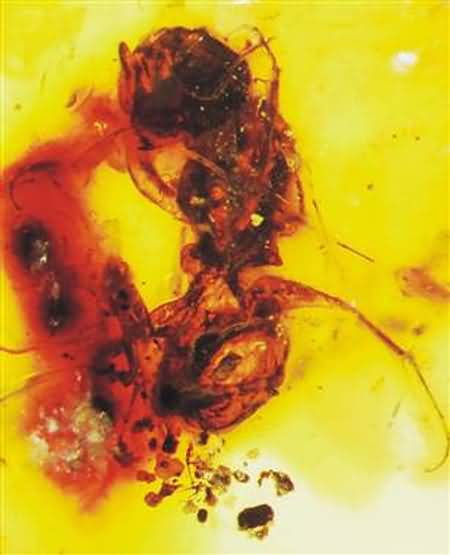
Bees have been around for about a hundred million years (or more), but humans have been around for less than a quarter of a million years. So of course bees know better than we do what is good for them. They've been around for more than four hundred times as long as we have!
The problem nowadays is that bees have been messed around with, and their environment has been trashed since humans have arrived. Unless something is done very soon they will surely die out: and we'll be in a mess without them.
You can find out a lot more about these problems which the bees have to face by doing some research. Take a look at the recommended books, websites and films on the Links page for more information.
What are the bees up against?
Some of the many problems which bees face. Click a line to see more detail.
- Deforestation and Lack of Nesting Sites
- Destruction of hedgerows and meadows
- Monoculture
- Pollution
- Pesticides and Herbicides
- Movement of bees around the World
- Interference in their lives
- Robbing their honey
- Climate Change
Deforestation and Lack of Nesting Sites

In the wild honeybees like to make their nests in hollows in trees or in crevices in rocks. Due to deforestation there are very few ancient forests left. Trees naturally grow to their full size, then when they are very old, the inside of the tree can decay leaving a cavity inside. The tree is still alive as the living part of a tree is just under the bark.
There are very few large trees with a suitable cavity nowadays. Needless felling of hollow trees because of the misconception that they are in some way a danger or about to fall down is another symptom of a overly risk-averse, profit-oriented approach.
There are still wild honeybees, but they are not as numerous as they used to be. Some are lucky and find a hollow in a tree or maybe a handy space in a wall cavity in a building.
Destruction of Habitat
Bees need flowers and flowers need bees. They have co-evolved for millions of years.
They are creatures of the woodland, hedgerow and meadow. They need flowering plants, including trees such as fruit and nut trees in order to find food in the form of nectar and pollen.
There are fewer dry stone walls as the fields get bigger. It is costly to replace them when they fall down, but dry stone walls have a lot of crevices where wildlife can hide away.
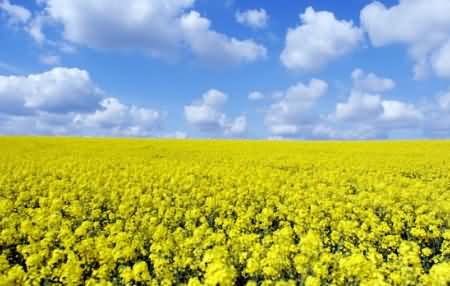
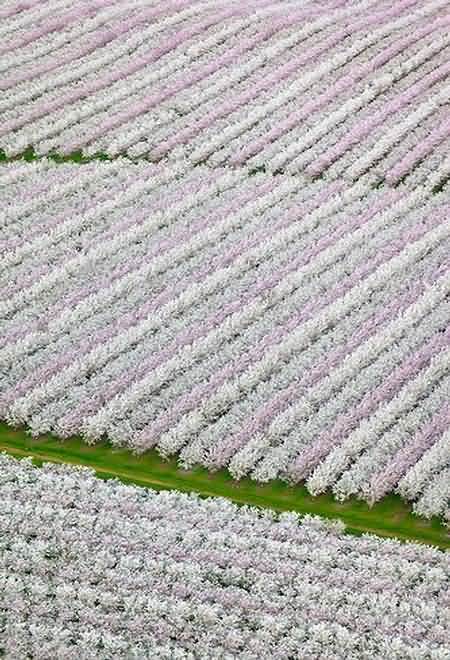
Monoculture
Modern farming methods are on a much larger scale than in the past. Farming is more intensive, less land is left to lie fallow to recover for the next crop. The fields are larger to allow machinery to move around more effectively, which results in loss of hedgerows.
Flowering plants need the bees, so their brightly coloured petals, fragrant scents and sweet nectar are produced to attract them. Bees can't be everywhere at once, so plants take turns to produce pollen and nectar, choosing different times of the day and different times of the year. That way the plants get the bees' attention, and the bees get supplies throughout the spring, summer and autumn.
In the large fields, instead of growing small patches or strips of different sorts of crop, farmers sow huge areas of one crop. This is called 'monoculture'. It makes it easier to sow, tend and harvest on an industrial scale, but does nothing for wildlife, particularly when the crops are the same for many many miles.
In America the situation is even worse. Thousands of beehives are loaded onto the back of lorries and transported all over America to pollinate the crops such as almonds, blueberries, peaches, apples etc.
These crops are not grown in small orchards with other flowers nearby to provide variety. These crops are grown in unbelievably vast tracts of land with mile after mile of one crop. Of course the farmers spray the crops to kill pests…
Pollution
Bees use their sense of smell to communicate and when foraging. They can smell the flowers from a considerable distance.
For the last century or so, humans have filled the air with coal smoke, petrol and diesel fumes and tyre dust.
Recent moves to limit the pollution from vehicle exhausts has stopped it getting worse as quickly, but the bees' noses are far more sensitive than ours, so the cleanest of our machines are still very smelly to them. This makes finding the flowers much harder.
Pesticides and Herbicides
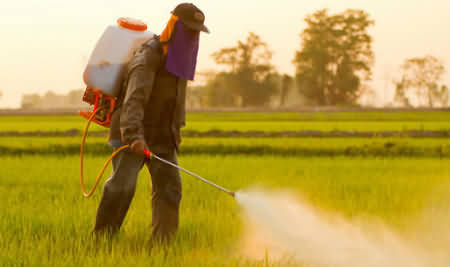
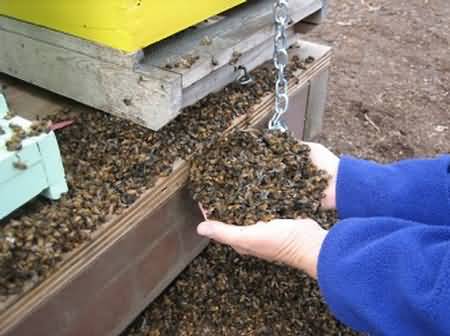
Any large field of the same crop will attract pests, so the farmer will spray with chemicals to kill them. With fewer hedgerows, birds and hedgehogs (who would naturally eat the pests) have no places to live, so the situation gets worse and worse.
Crops such as oilseed rape are grown in huge fields. The seed is coated in a systemic pesticide, so the plant is toxic to wildlife. Bees find the flowers irresistable, but it is not healthy for them to be consuming vast quantities of the same food. It would be like us trying to live on ice cream! The pesticide accumulates in the bees and affects their navigational abilities. They forget where they are and die before they can find their way home to the hive.
The fields are huge and high crop yields are required. Farmers do not want to have weeds competing with their crops or have insects eating them, so they apply herbicides to kill any weeds and pesticides to kill insect pests. Unfortunately, this also kills the many beneficial insects. Without insects, birds (who would naturally eat the insects) have a hard time finding food. The insects they can find may well have been poisoned by the pesticides, which can make the birds sick. So of course, the farmer then has to spray even more toxins onto the crop to make up for the lack of the birds' help.
Some margins of fields are left untreated 'for the wildlife' but pesticides and herbicides drift into those margins and into the hedgerows, with disastrous consequences.
Worse still are the systemic pesticides which are used as seed coating. The pesticide is present in all parts of the plant including the pollen and nectar. Any living thing (including ourselves) will be getting an unhealthy dose of these pesticides when we eat. We know that birds suffer memory loss as a result of ingesting this, just as the bees do. There is a suspicion that it affects humans in a similar way.
These pesticides, herbicides and the medications given to livestock can persist in the soil for a long time. This upsets the whole ecosystem. Without small living creatures, fungi etc in the soil nutrients are not broken down for the plants. The farmer has to add more and more artificial fertilizer in order to maintain the yield.
Movement of Bees Around the World
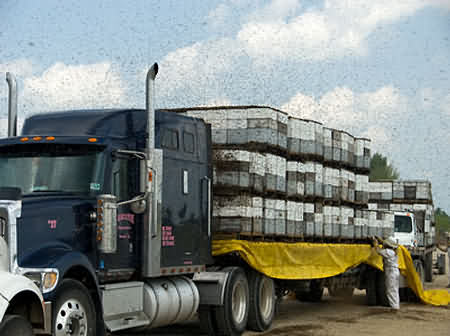
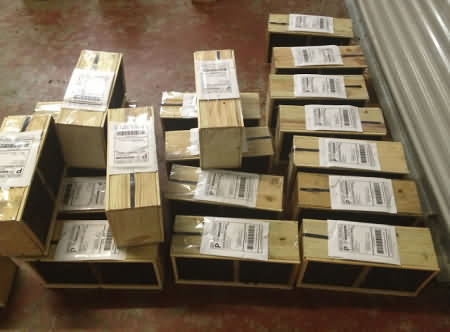
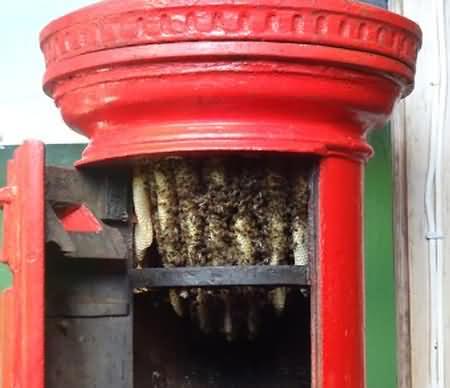
In this country there are few wild colonies of bees. They are out there, but most bees are kept by beekeepers.
In the old days if you wanted to keep a few bees, you would collect a swarm and put them in a hive or a skep. They would be local bees, used to the conditions in your local area.
Round here, that used to mean the native British black bee. The black bee is well suited to the British climate. It is hardy, will tolerate the cold and damp. It will fly in rainy conditions. It can make its food stores last a long time through the winter months and the black bee queens stop laying eggs well before winter sets in. However they can be a bit grumpy and they don't make as much honey.
Beekeepers usually want their bees to be easy to work with and to produce a lot of honey. To get gentler bees who produce a lot of honey, they brought in bees from foreign lands such as Italy. However the climate in Britain is not as gentle as the Italian weather and these bees are not as good at surviving our winters.
Importing bees from all over the place is a problem because it can bring in bee diseases and parasites that native bees don't have resistance to.
In the early years of the 20th century, native Black Bees almost died out due to diseases on imported bees, exploitation by Victorian beekeeping approaches and neglect as a result of the Great War. Isle of Wight Disease (a small parasitic mite) is blamed for much of this, but in reality it was not the prime cause. So even more bees were imported, bringing in more disease and parasite problems.
In addition, some beekeepers spend a lot of time trying to find the 'perfect' bee. They select bees that they like and breed from them. They do this in all sorts of ways which you can read about elsewhere. It really isn't an enjoyable read. And once again, it is humans meddling when they should step back.
In recent years, there has been a resurgence in the Black Bee population, and it is noticeable that local 'mongrel' bees are getting darker in colour as more Black Bee genes are in them.
Interference in their Lives
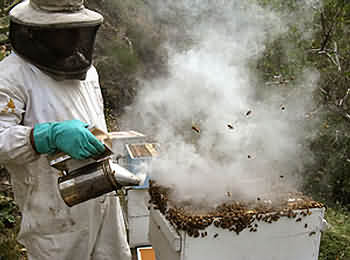
Generally speaking, the commercial way of keeping bees means that there is a lot of intrusion and interference in the life of the bees.
The British Beekeeping Association recommends that in the foraging season (Spring to Autumn) weekly inspections are carried out. This means that the beekeeper will take the lid off the hive to see what is going on inside. This is a bit like doing a operation on your stomach to see if your digestion is working properly.
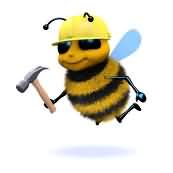
Firstly all the atmosphere of the hive is let out. The bees work very hard to keep their hive at a constant temperature. They also regulate the humidity and the distribution of bee pheromones. It takes the bees several days to get everything back to normal, then just a few days later the lid is lifted and they have to start all over again.
Not content with just having a quick look to see all is well, the beekeeper blasts the bees with smoke. This terrifies bees; they think their hive is on fire, they fill up with honey in case they have to manage with no growing plants. They cower at the deepest part of the hive in the hope of surviving the fire. This makes them a bit easier for the beekeeper to handle, but it really doesn't calm them.
Then the beekeeper proceeds to look through every part of the hive to see what the bees are up to. Are they making enough honey? Are they producing enough baby bees? Are they producing too many boys (drones)? Are there signs that they may be about to swarm? Are there any diseases present?
The beekeeper may decide to rearrange the order of the combs in the hive, may take out some or all of the honey, may apply treatments (often synthetic pyrethroids: not a great thing to treat insects with, you'd think, but they do!) They feed the bees with sugar (or even worse, high-fructose corn syrup) to make up for the robbed honey. No wonder the poor bees get stressed.
It typically takes a bee colony three to four days to recover from the effects of a hive inspection, to replace the lost warmth and pheromones and to return to normal.
You might imagine how stressed you would be if a giant came and took the roof of your house, let all your warm air out, reached in and rearranged your furniture and took away the food in your cupboards, squirted you with chemicals and pumped smoke into your eyes! Then the following week, they did it all over again!
Robbing Honey
Honey is for bees: bees are not for honey
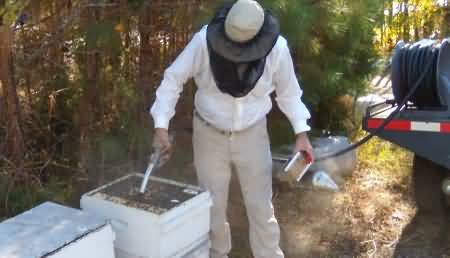
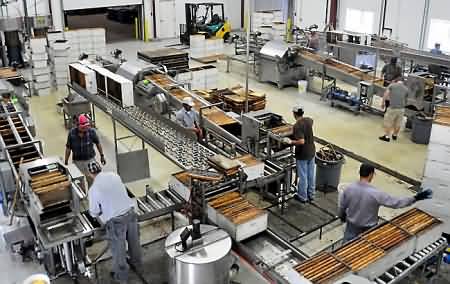
Bees make honey for a reason. This reason is to feed themselves when there is no nectar to be had. Honey keeps them going through the winter, through times when there are no nectar plants available, or through times when the weather is bad.
They spend a lot of time gathering the nectar and bringing it back to the hive. Nectar will not keep in its raw state; it has to be processed by the bees to make it into honey. This takes a lot of energy.
To eat the honey they first have to fetch water to dilute it back into a usable form. This takes further energy.
Beekeepers take a lot of honey from their bees. After all, they can sell it and make money from such a desirable product. To make up for this, they give their bees sugar syrup or fondant to eat. As we all know, sugar is not a very nutritious product and lacks the enzymes and nutrients contained in honey.
Bees can use sugar to make a sort of honey, but it is not at all the same as honey made from nectar from flowers. You can really taste the difference if you are lucky enough to taste honey made by bees never fed artifically. Unfortunately, very few people ever get to taste that.
Climate Change
Our climate is changing faster than evolution can keep pace with. Left to their own devices, bees would most probably evolve to match the climate change, but we are making it harder for them.
Bees brought in from abroad are not used to the local climate. A cold, wet, long or unusually mild winter puts a strain on the bees. Dry summers make plants conserve their moisture and they may not be able to make nectar available to the bees. Stormy weather may make it impossible for bees to go out on foraging flights.